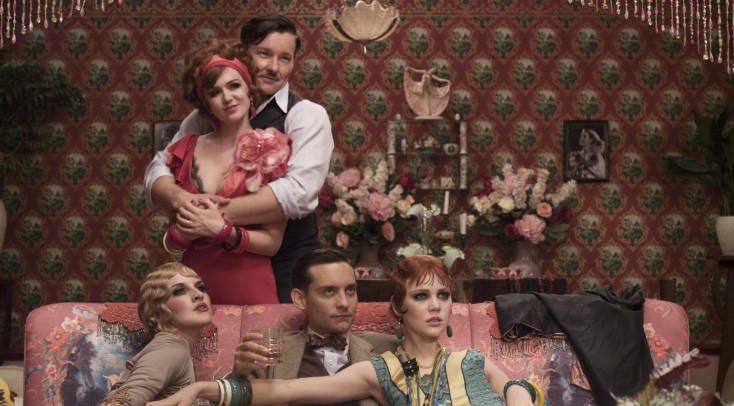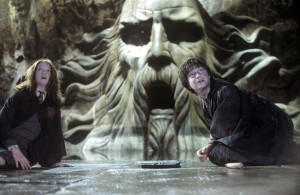By JAMES DAWSON
Front Row Features
Baz Luhrmann’s garish adaptation of F. Scott Fitzgerald’s “The Great Gatsby” managed to remain remarkably faithful to the classic novel’s words while altering its tone enough to turn that bitter morality tale into a flamboyantly over-the-top farce.
As one of many critics appalled by Luhrmann’s grotesque “Baz-tardization” of that book, I was challenged by somebody who liked the movie to name a film adaptation that actually did justice to its source material. No problem!
Choosing films for each decade from the 1930s to the present, and limiting the field to movies made from books I actually have read, these were the first titles that came to mind. Some are almost word-for-word print-to-screen translations, others vary wildly from the original text, but all stand as worthy and impressive companions to the works that inspired them.
1930s: “The Wizard of Oz.” The Victor Fleming film converted L. Frank Baum’s children’s fantasy into a musical, turned Dorothy’s silver slippers ruby red and changed the book’s ending, which proves that an adaptation (by Noel Langley, Florence Ryerson and Edgar Allan Woolf, in this case) doesn’t have to be a slavish copy of the original text to be a completely successful classic in its own right.
1940s: “Double Indemnity” and “The Postman Always Rings Twice.” It was so hard choosing between these two brilliantly noirish James M. Cain novels-to-films that I’m listing them both. The former became a 1944 Billy Wilder masterpiece that proved even Fred MacMurray could get down and dirty when a tough broad like Barbara Stanwyck was calling the shots. Two years later, Lana Turner and John Garfield steamed up the screen as another mismatched pair with a mind for murder.
1950s: “Rear Window,” adapted and expanded by John Michael Hayes from the short story “It Had to Be Murder” by Cornell Woolrich, became one of director Alfred Hitchcock’s most memorable films. Flawless casting of an immobilized James Stewart, an irresistible Grace Kelly and a villainous pre-“Perry Mason” Raymond Burr made this a fascinating film about a very special room with a view.
1960s: “Lolita” capitalized on its Vladimir Nabokov source novel’s notoriety with an ad campaign that asked “How Did They Ever Make a Film of ‘Lolita?'” Director Stanley Kubrick pulled off the feat by casting an impeccable James Mason as the erudite pedophile Humbert Humbert, Peter Sellers as his Quilty/guilty conscience nemesis and Sue Lyon as the titular object of his improper obsession. Black humor rarely has been as devious, dark or delicious.
1970s: “A Clockwork Orange” turned the Anthony Burgess novel into a pop-art dystopia with Malcolm McDowell as one of cinema’s most entertainingly amoral antiheroes. Yes, I realize I selected Kubrick films to represent two decades in a row, but genius won’t be denied. (And to address the obvious: I didn’t choose Francis Ford Coppola’s first two “Godfather” films for this decade’s picks because I never read the original Mario Puzo novel—which may not be one that most people would regard as a literary classic, anyway.)
1980s: “Blade Runner” made lots of changes (including the title, fortunately) to the Philip K. Dick SF novel “Do Androids Dream of Electric Sheep?” But director Ridley Scott, and screenwriters Hampton Fancher and David Peoples, retained the original’s bad-robot sense of paranoia and messy moral ambiguity.
1990s: “Fight Club” screenwriter Jim Uhls turned the cult novel by Chuck Palahniuk into a shockingly brutal but nastily hilarious blueprint for visionary director David Fincher. The movie’s ending is the exact opposite of the one in the book, but works so much better than the original that it’s hard to resent the change.
As for 21st-century adaptations that succeeded, the three most obvious choices may be director Tim Burton’s terrific take on Lewis Carroll’s “Alice in Wonderland,” Julie Taymor’s audacious and inspired gender-switch version of Shakespeare’s “The Tempest” and Rowan Joffe’s cleverly period-updated “Brighton Rock” (which easily stands alongside the excellent 1947 film version of that Graham Greene novel).
As for successful recent movies adapted from popular (as opposed to more traditionally classic) sources, Terry Zwigoff’s “Ghost World” and Stephen Frears’ “Tamara Drewe” made two wonderful graphic novels into equally enjoyable films. Ang Lee’s “Brokeback Mountain” expanded a short story into a cinematic masterpiece. “Harry Potter and the Chamber of Secrets” and “Lemony Snicket’s A Series of Unfortunate Events” became two of the best all-ages entertainments of the past decade.
(A case probably could be made that Peter Jackson’s movies of J.R.R. Tolkien’s “Lord of the Rings” trilogy and “The Hobbit” belong on this list as well, but I never made it through even one of Tolkien’s books without skimming, so I have to recuse myself from passing judgment.)
So while director Luhrmann’s garishly goofy “The Great Gatsby” may be the cinematic equivalent of Weird Al Yankovic’s polka-crazed but lyrics-faithful rendition of Queen’s “Bohemian Rhapsody”—except without the intentional humor—never let it be said that successfully translating great books to the big screen is impossible. Sometimes, projects that get greenlit in Hollywood actually do manage to attain the desired ideal symbolized by the green light at the end of Daisy Buchanan’s dock.






